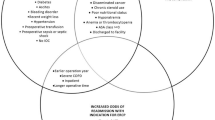Abstract
Introduction
Hospital readmissions constitute an important component of associated costs of a disease and can contribute a significant burden to healthcare. The majority of studies evaluating readmissions following laparoscopic cholecystectomy (LC) comprise of single center studies and thus can underestimate the actual incidence of readmission. We sought to examine the rate and causes of readmissions following LC using a large longitudinal database.
Methods
The New York SPARCS database was used to identify all adult patients undergoing laparoscopic cholecystectomy for benign biliary disease between 2000 and 2016. Due to the presence of a unique identifier, patients with readmission to any New York hospital were evaluated. Planned versus unplanned readmission rates were compared. Following univariate analysis, multivariable logistic regression model was used to identify risk factors for unplanned readmissions after accounting for baseline characteristics, comorbidities and complications.
Results
There were 591,627 patients who underwent LC during the studied time period. Overall 30-day readmission rate was 4.94% (n = 29,245) and unplanned 30-days readmission rate was 4.58% (n = 27,084). Female patients were less likely to have 30-day unplanned readmissions. Patients with age older than 65 or younger than 29 were more likely to have 30-day unplanned readmissions compared to patients with age 30–44 or 45–64. Insurance status was also significant, as patients with Medicaid/Medicare were more likely to have unplanned readmissions compared to commercial insurance. In addition, variables such as Black race, presence of any comorbidity, postoperative complication, and prolonged initial hospital length of stay were associated with subsequent readmission.
Conclusion
This data show that readmissions rates following LC are relatively low; however, majority of readmissions are unplanned. Most common reason for unplanned readmissions was associated with complications of the procedure or medical care. By identifying certain risk groups, unplanned readmissions may be prevented.

Similar content being viewed by others
References
Hassler KR, Jones MW (2020) Laparoscopic cholecystectomy. In: StatPearls, StatPearls Publishing, Treasure Island (FL). https://www.ncbi.nlm.nih.gov/books/NBK448145/. Accessed 13 Mar 2020
Kapoor T, Wrenn SM, Callas PW, Abu-Jaish W (2018) Cost analysis and supply utilization of laparoscopic cholecystectomy. Minim Invasive Surg. https://doi.org/10.1155/2018/7838103
Kim Y, Wima K, Jung AD, Martin GE, Dhar VK, Shah SA (2017) Laparoscopic subtotal cholecystectomy compared to total cholecystectomy: a matched national analysis. J Surg Res 218:316–321
Strosberg DS, Nguyen MC, Muscarella P, Narula VK (2017) A retrospective comparison of robotic cholecystectomy versus laparoscopic cholecystectomy: operative outcomes and cost analysis. Surg Endosc 31(3):1436–1441
Moghadamyeghaneh Z, Badami A, Masi A, Misawa R, Dresner L (2020) Unplanned readmission after outpatient laparoscopic cholecystectomy. HPB 22:702–709
Rosero EB, Joshi GP (2017) Hospital readmission after ambulatory laparoscopic cholecystectomy: incidence and predictors. J Surg Res 219:108–115
Tang H, Dong A, Yan L (2015) Day surgery versus overnight stay laparoscopic cholecystectomy: a systemic review and meta-analysis. Dig Liver Dis 47(7):556–561
Bailey MK, Weiss AJ, Barrett ML, Juang J (2019) Characteristics of 30-day all-cause hospital readmissions, 2010–2016. HCUP data: statistical brief #248. https://www.hcup-us.ahrq.gov/reports/statbriefs/sb248-Hospital-Readmissions-2010-2016.jsp?utm_source=ahrq&utm_medium=en-13&utm_term=Safety_Program&utm_content=13&utm_campaign=ahrq_en6_18_2019. Accessed on 20 Apr 2020
Awolaran O, Gana T, Samuel N, Oaikhinan K (2017) Readmissions after laparoscopic cholecystectomy in a UK District General Hospital. Surg Endosc 31(9):353408
McIntyre C, Johnston A, Foley D et al (2020) Readmission to hospital following laparoscopic cholecystectomy: a meta-analysis. Anaesthesiol Intensive Ther 52(1):47–55
Hines AL, Barrett ML, Jiang HJ, Steiner CA (2014) Conditions with the largest number of adult hospital readmissions by payer. 2011 AHRQ. https://www.hcup-us.ahrq.gov/reports/statbriefs/sb172-Conditions-Readmissions-Payer.pdf. Accessed 4 Aug 2020
Acknowledgements
We acknowledge the biostatistical consultation and support provided by the Biostatistical Consulting Core in the School of Medicine, Stony Brook University.
Author information
Authors and Affiliations
Corresponding author
Ethics declarations
Disclosures
Dr. Pryor is a speaker for Ethicon, Gore, Merck and Stryker, and a consultant for Medtronic. She has research support from Baronova and Obalon. Drs. Altieri, Yang, Madani, Zhu, Castillo, Talamini, Zhu, and Zhang, have no conflicts of interest or financial ties to disclose.
Additional information
Publisher's Note
Springer Nature remains neutral with regard to jurisdictional claims in published maps and institutional affiliations.
Rights and permissions
About this article
Cite this article
Altieri, M.S., Yang, J., Zhang, X. et al. Evaluating readmissions following laparoscopic cholecystectomy in the state of New York. Surg Endosc 35, 4667–4672 (2021). https://doi.org/10.1007/s00464-020-07906-9
Received:
Accepted:
Published:
Issue Date:
DOI: https://doi.org/10.1007/s00464-020-07906-9




